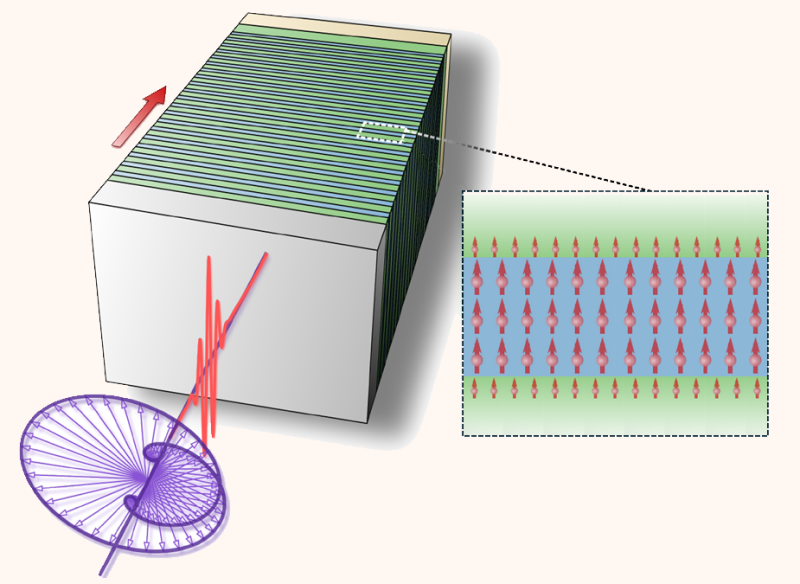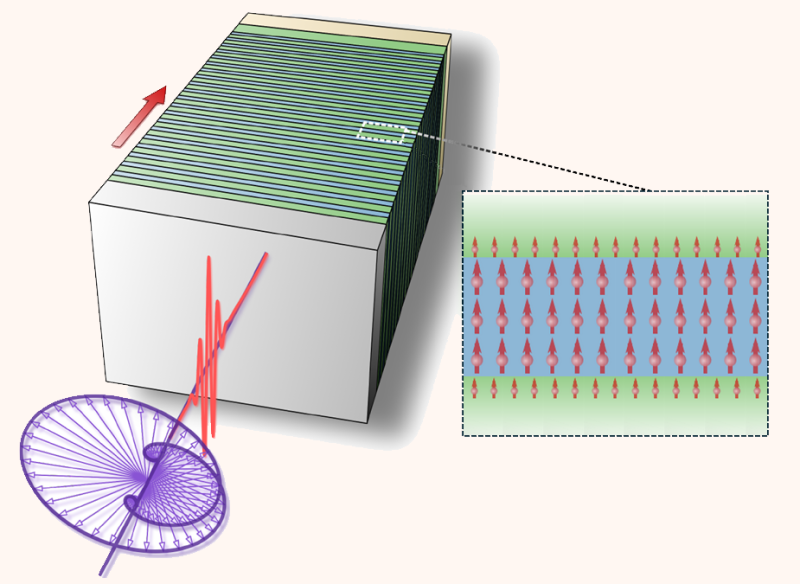Ultrafast Lasers Induce Spin Currents Directly
The field of “spintronics” promises faster and more efficient electronic devices than those currently available, but such technology will require a rapid, controlled way to create spin currents—organized streams of electrons with aligned spins that can be used to encode information in magnetic materials. Now researchers have demonstrated that short laser pulses can create spin currents within a few femtoseconds (10–15 s)—some 30 times faster than previous techniques [1]. The method, they believe, should provide a more flexible and precise way to generate spin currents by taking advantage of the control that physicists have over laser light.
Researchers have previously used lasers to generate spin currents, but only indirectly. On interaction with a magnetic material, for example, a laser pulse may stir up a current of electrons of mixed orientation—half having spin directed along an applied magnetic field, and half against. If electrons with these different spins scatter off impurities at different rates, the stream will eventually contain electrons of one spin component only. “The laser has been a way to give energy to a material, and the spin currents then arise during the subsequent redistribution of the energy,” says Romain Géneaux of the University of Paris-Saclay. The creation of spin currents in this way requires a time of at least 100 femtoseconds (fs) or so, limiting achievable operating speeds for devices.
Now, building on earlier experiments, Géneaux and colleagues have shown how laser pulses can generate spin currents directly and in a much shorter time. They started by fabricating a test sample consisting of 20 alternating layers—each about 1 nanometer thick—of the magnetic materials cobalt (Co) and platinum (Pt). Such layered materials are often used in research on magnetic systems, as the many interfaces offer zones where electron spins can easily respond to magnetic fields. The researchers placed this sample in an external magnetic field directed perpendicular to the layers and strong enough to align the spins of conduction electrons in both the Co and Pt layers.
The team first probed the sample using a subfemtosecond pulse of circularly polarized light that traversed the alternating layers in the same direction as the magnetic field. By recording the absorption of this light by the sample, the researchers could determine the degree of magnetic ordering and thus the spin alignment in each of the magnetic materials. The researchers then hit the sample with a high-energy 4-fs pulse of linearly polarized infrared laser light designed to trigger a major rearrangement of the spins. Immediately after this pulse, they probed the sample again using the circularly polarized light to see how electrons in the Co and Pt atoms responded to the triggering pulse’s energy.
The data showed that the laser pulse caused a sudden change in the magnetic ordering within the sample. In the layers of cobalt, the degree of magnetic ordering fell by some 10% from its original value within the first 2 femtoseconds of the pulse. Meanwhile, over the same interval, the magnetic ordering in the platinum regions actually increased by a few percent.
To explain the observed behavior, Géneaux and colleagues performed calculations using a general approach known as density-functional theory, which approximates complex electron interactions with a simplified potential energy term based on the electron density. Because such calculations are computationally demanding, the researchers limited their theoretical model to just a few atomic layers around the Co and Pt interface, as the physics of systems made of thin layers is known to be dominated by the behavior at the interfaces. The calculation results agreed with the experiments, as well as with previous theoretical work on laser-light effects on spin transport. The researchers surmised that the laser pulse triggers—in a matter of femtoseconds—a spin current that flows from the cobalt layers into the platinum layers.
The team’s next goal, says Géneaux, is to explore existing structures used in spintronics devices to see how they behave when exposed to femtosecond laser pulses. The researchers also hope to push their work to create spin currents on even shorter timescales, perhaps as short as a few attoseconds (10–18 s). “The broader implication is that all of our knowledge and experience in optics—where we can precisely shape light in so many ways—can now be transferred to the shaping of spin currents,” Géneaux says.
Markus Münzenberg, an expert in interface and surface physics from the University of Greifswald in Germany, is impressed by the researchers’ achievement in managing to detect the spin-current transfer between materials on such short timescales. “This direct proof is of great importance if we want to make spintronics work at few femtoseconds,” Münzenberg says. Adding to this point, ultrafast laser specialist Marie Barthelemy from the Strasbourg Institute of Material Physics and Chemistry in France says, “Generating fast spin currents is crucial for increasing data processing speed and minimizing energy loss without any incoherent heating.”
–Mark Buchanan
Mark Buchanan is a freelance science writer who splits his time between Abergavenny, UK, and Notre Dame de Courson, France.
References
- R. Géneaux et al., “Spin dynamics across metallic layers on the few-femtosecond timescale,” Phys. Rev. Lett. 133, 106902 (2024).





